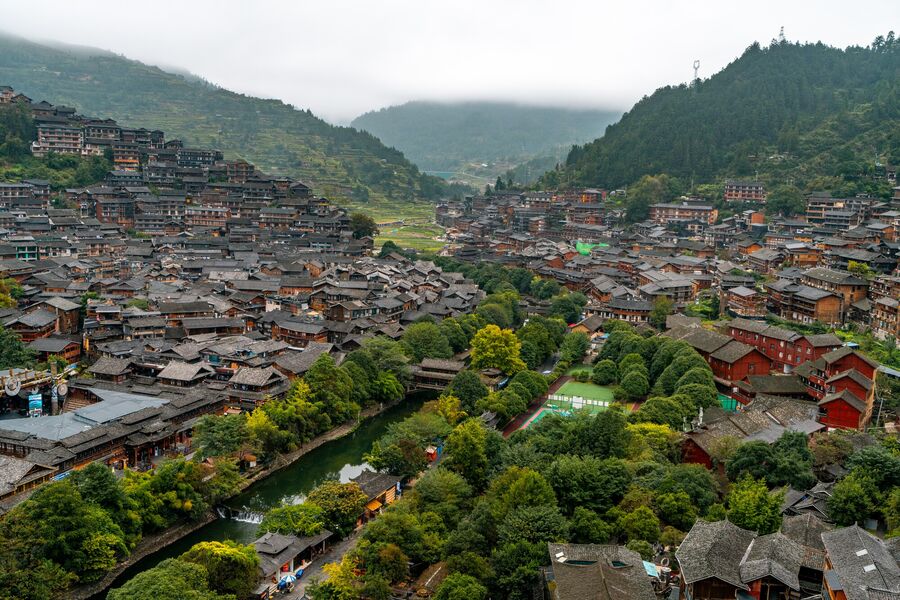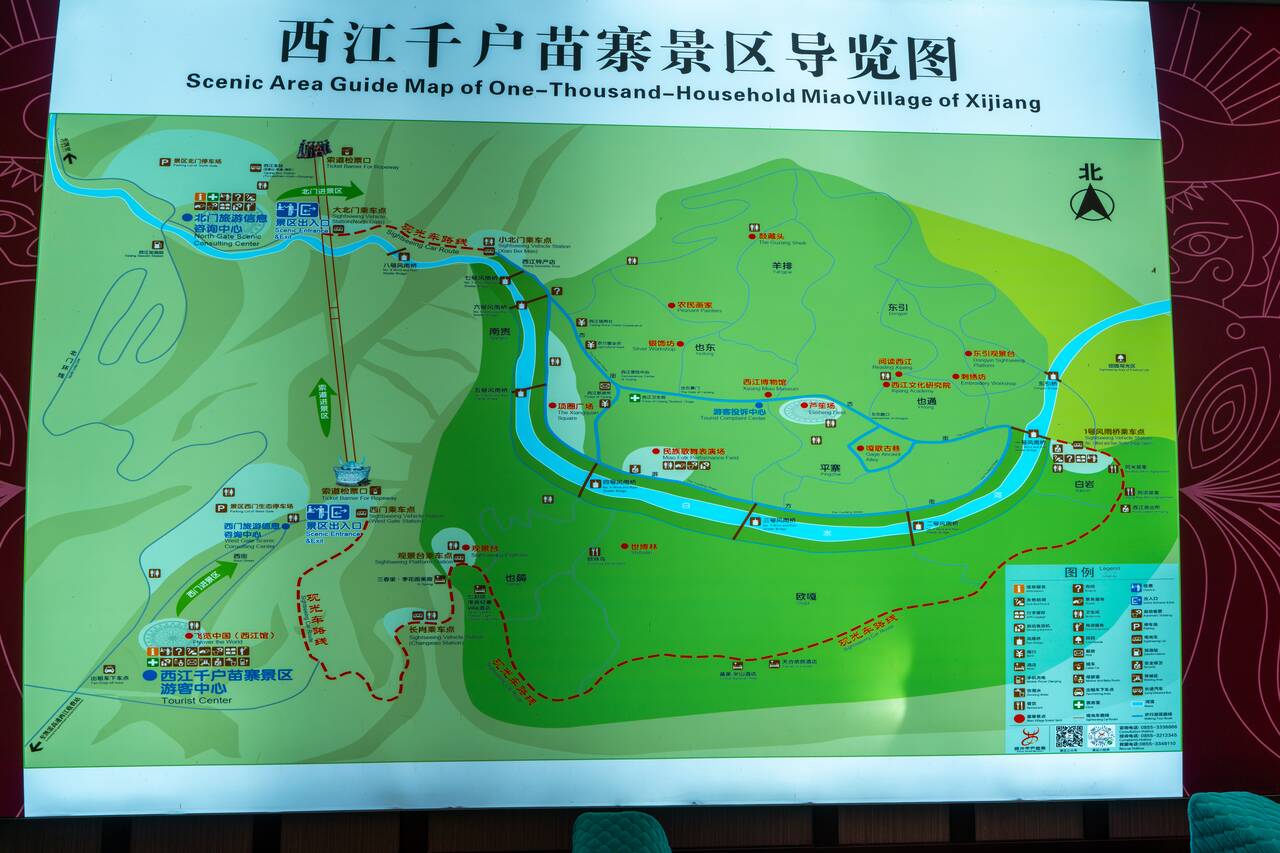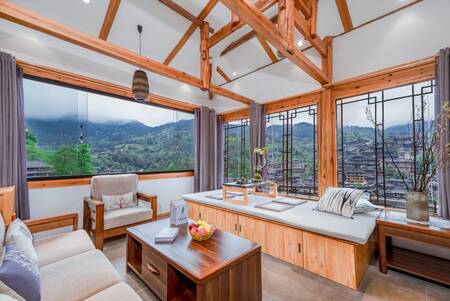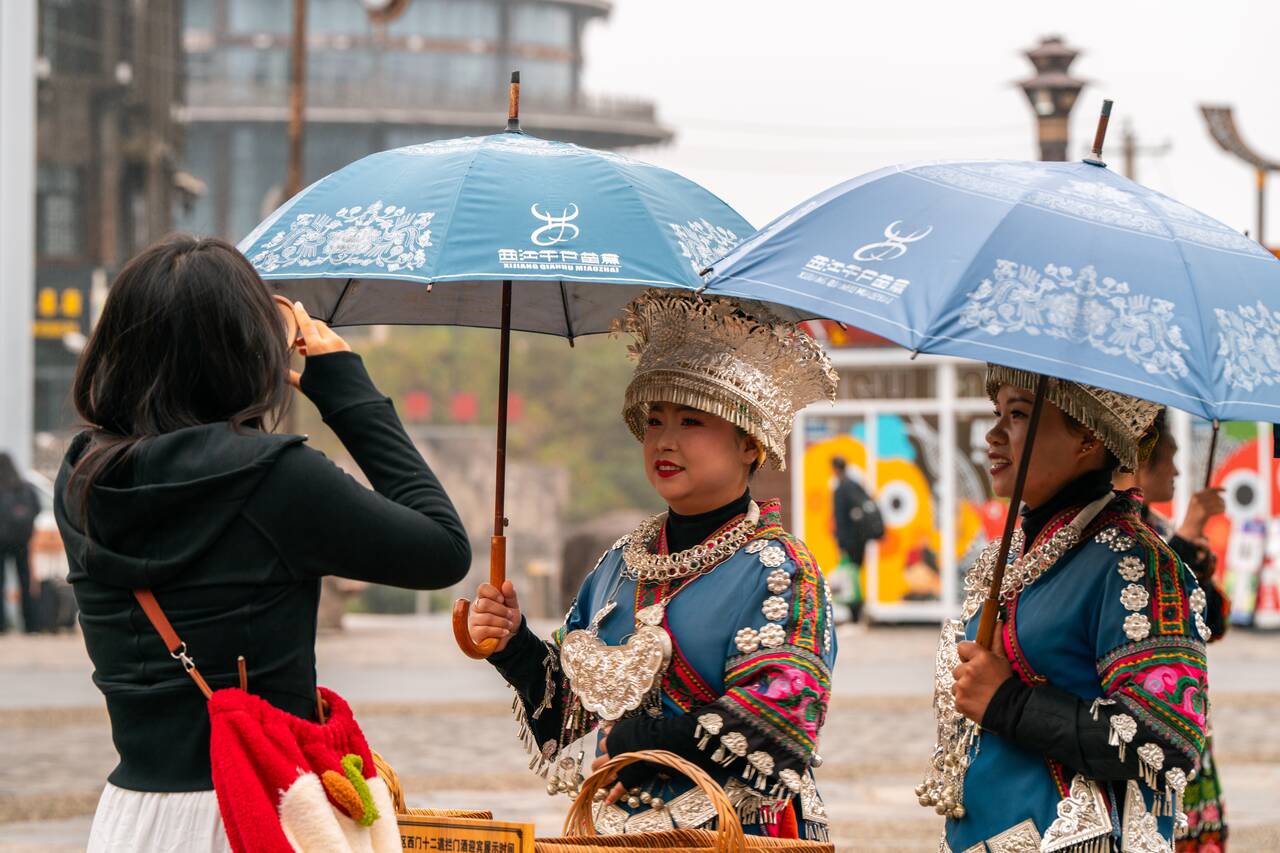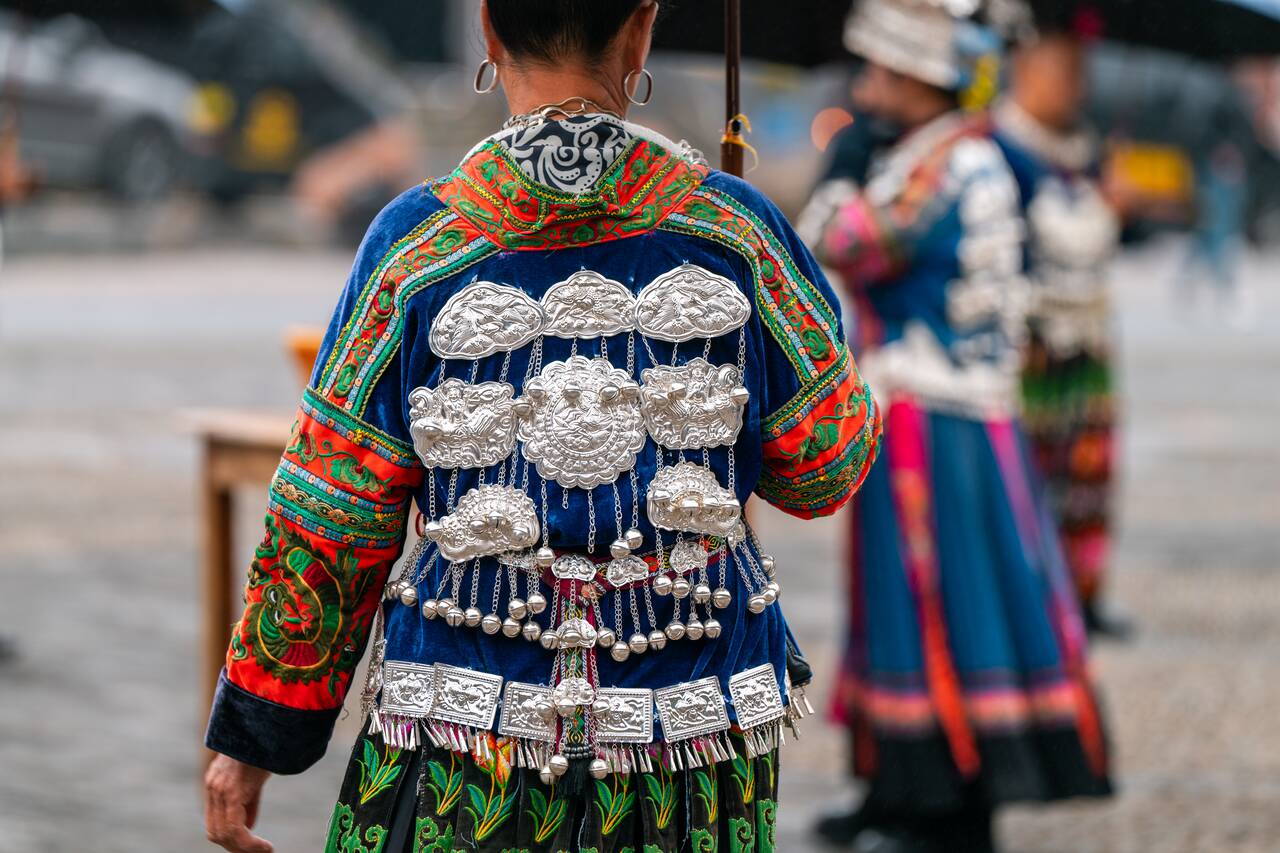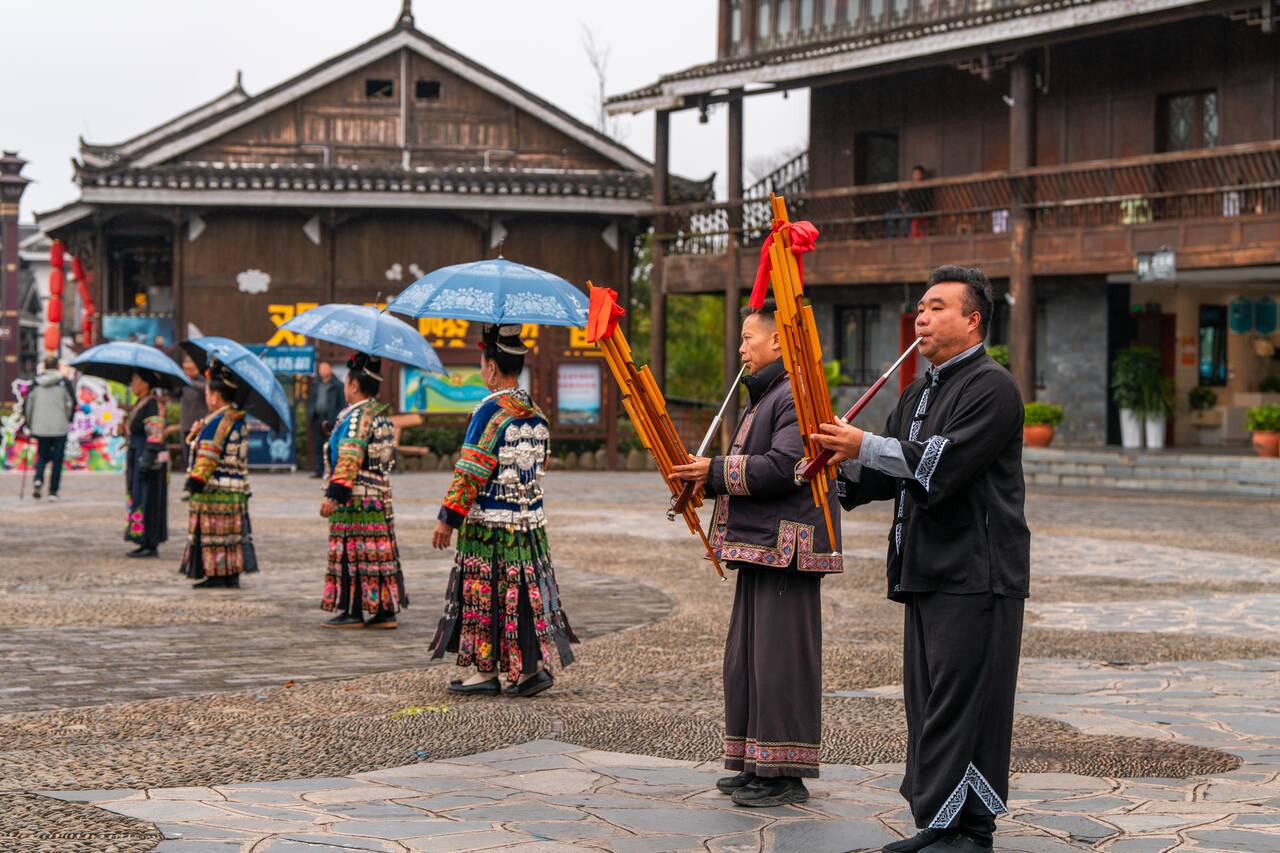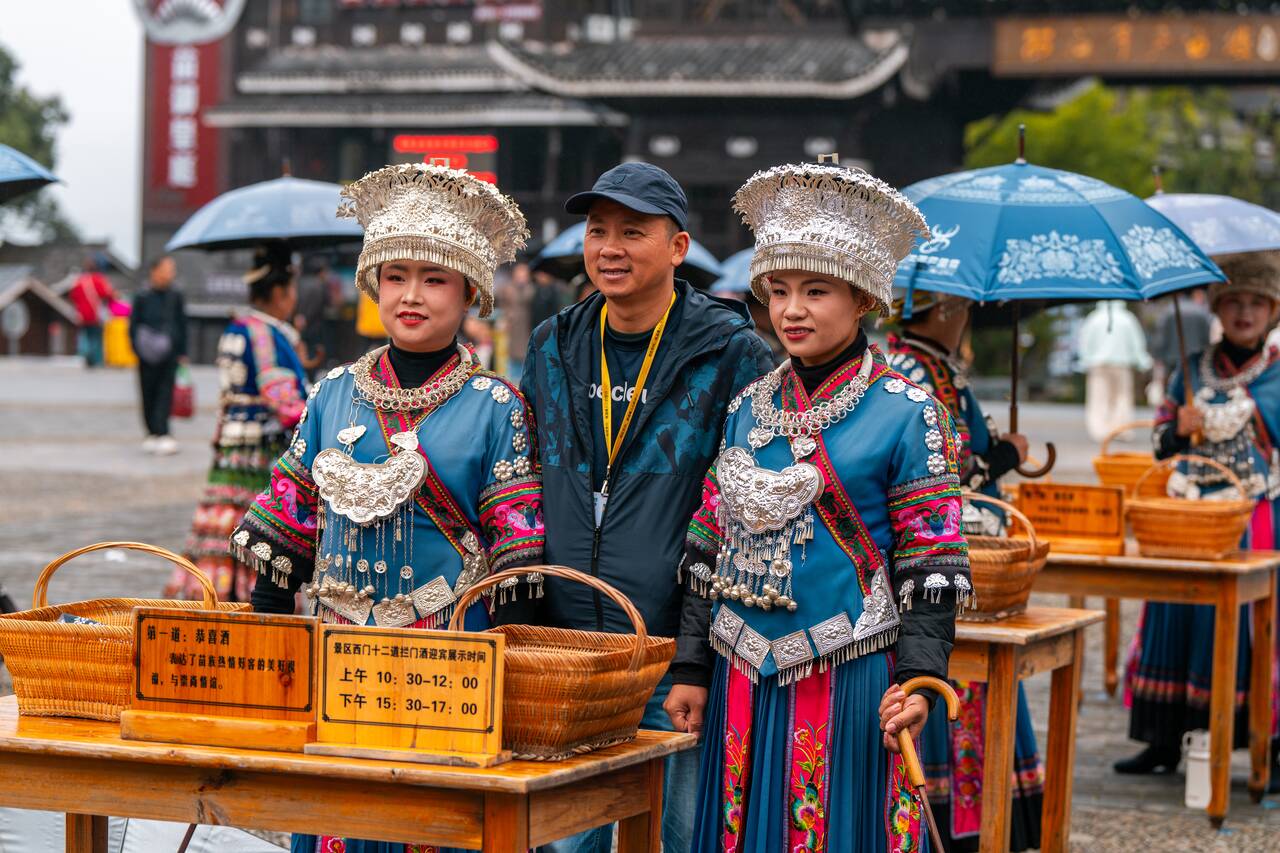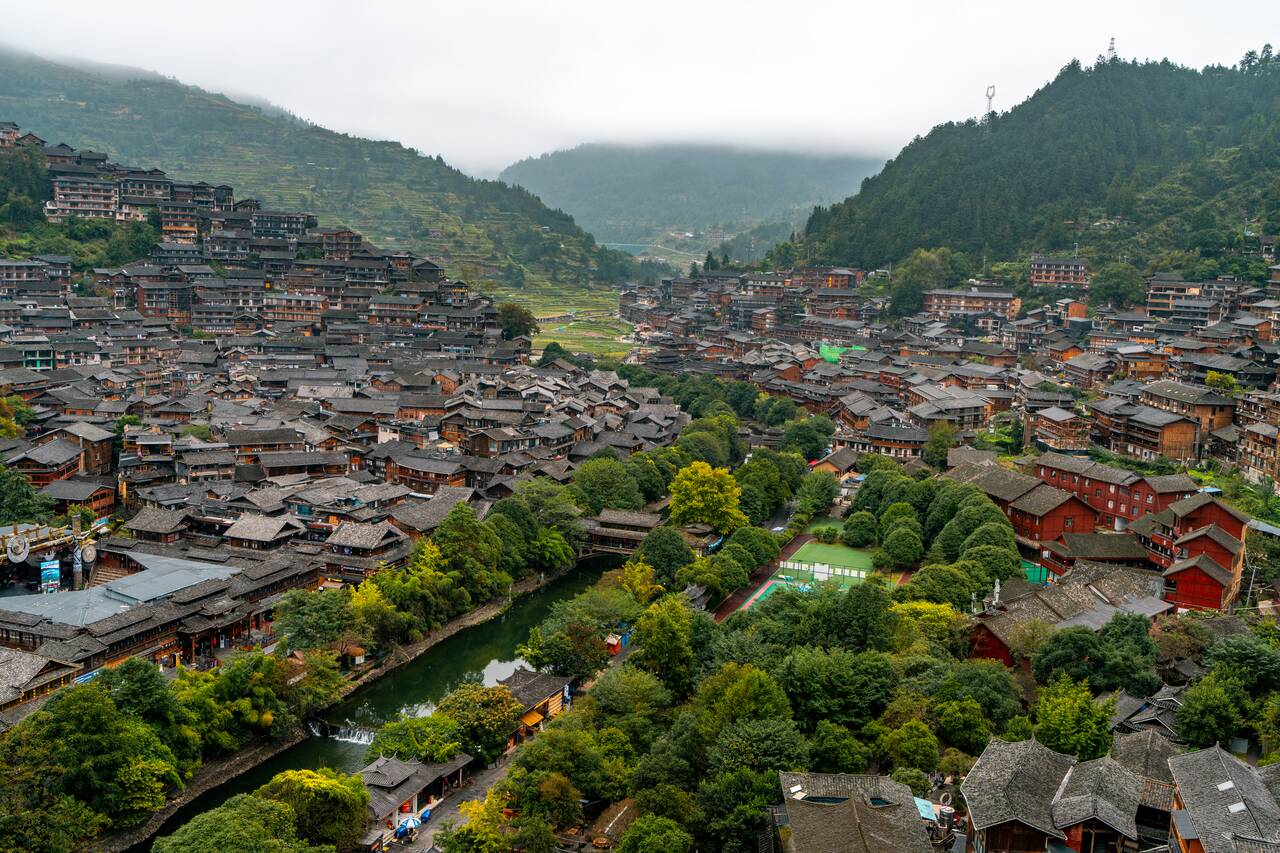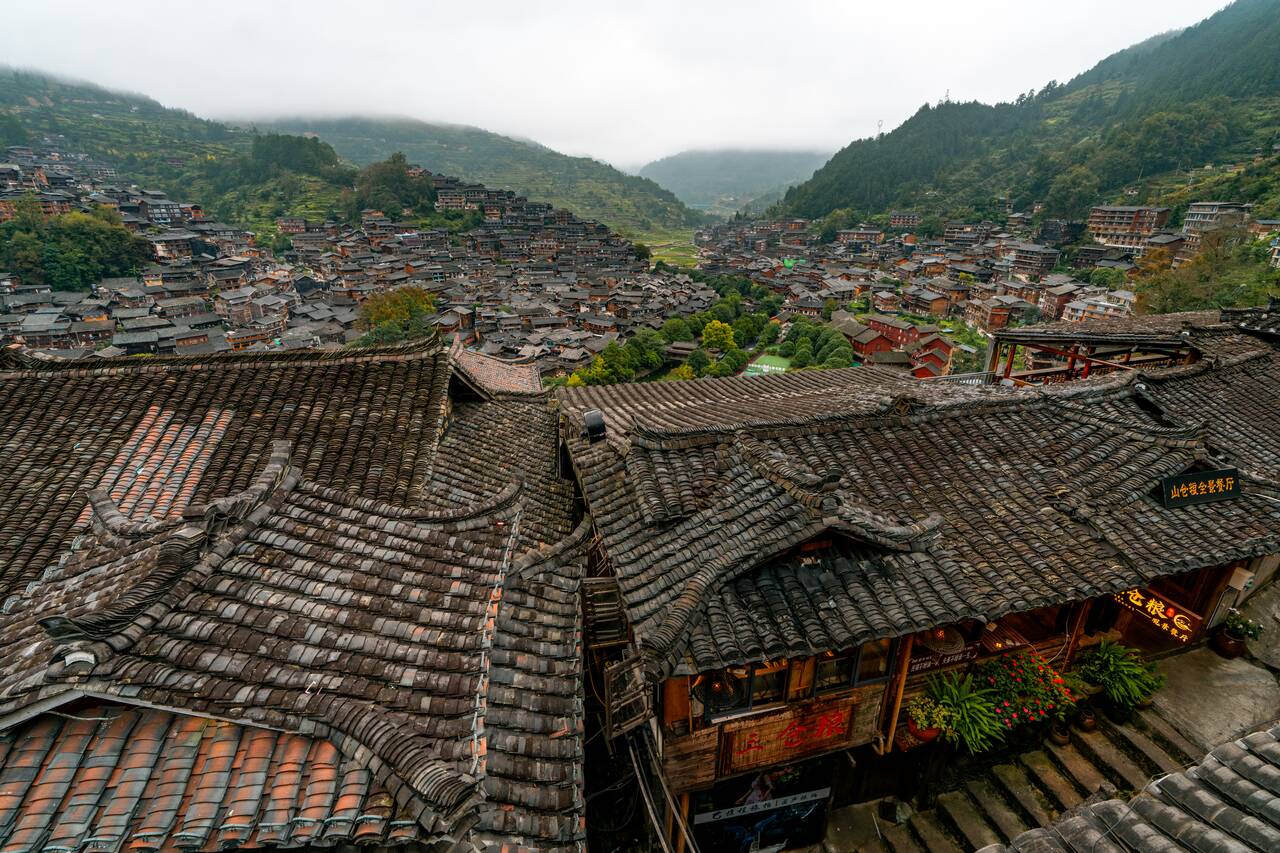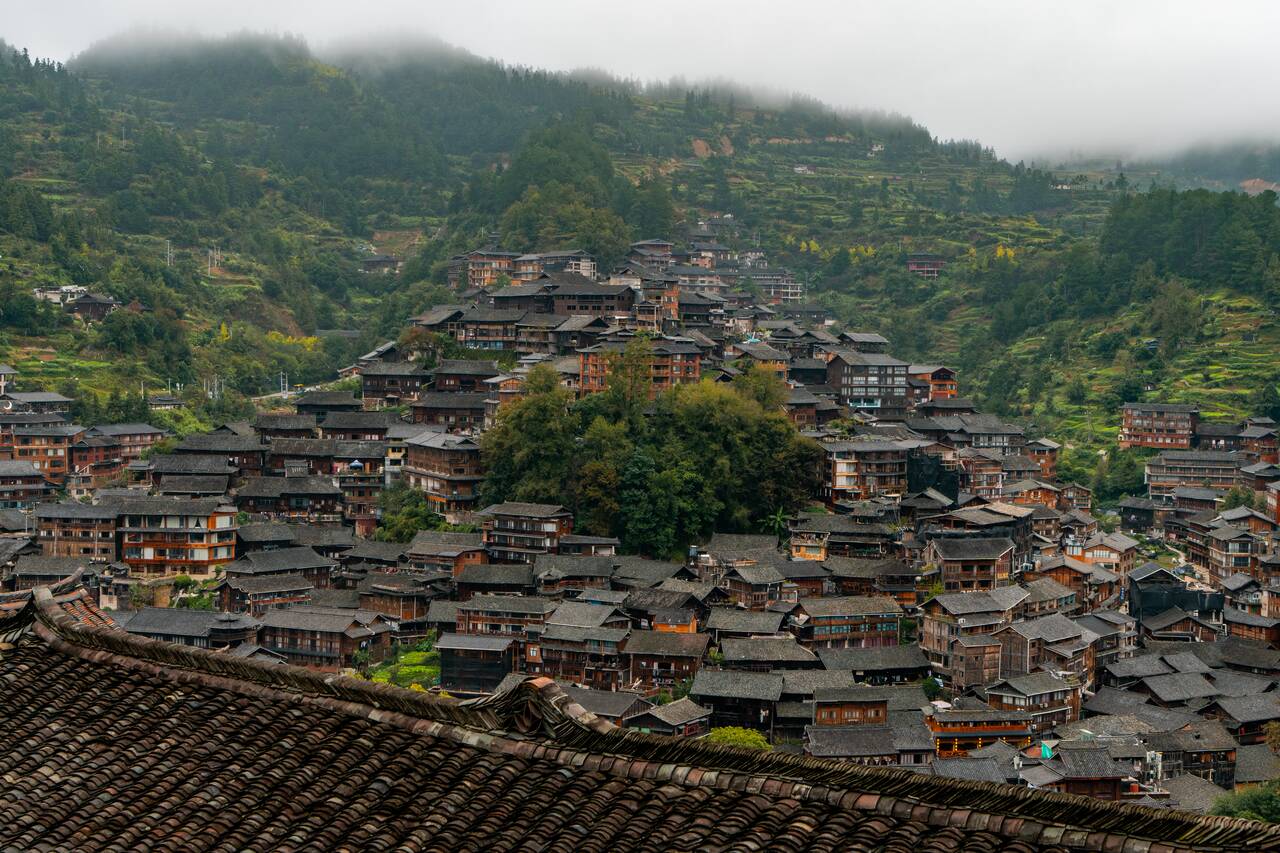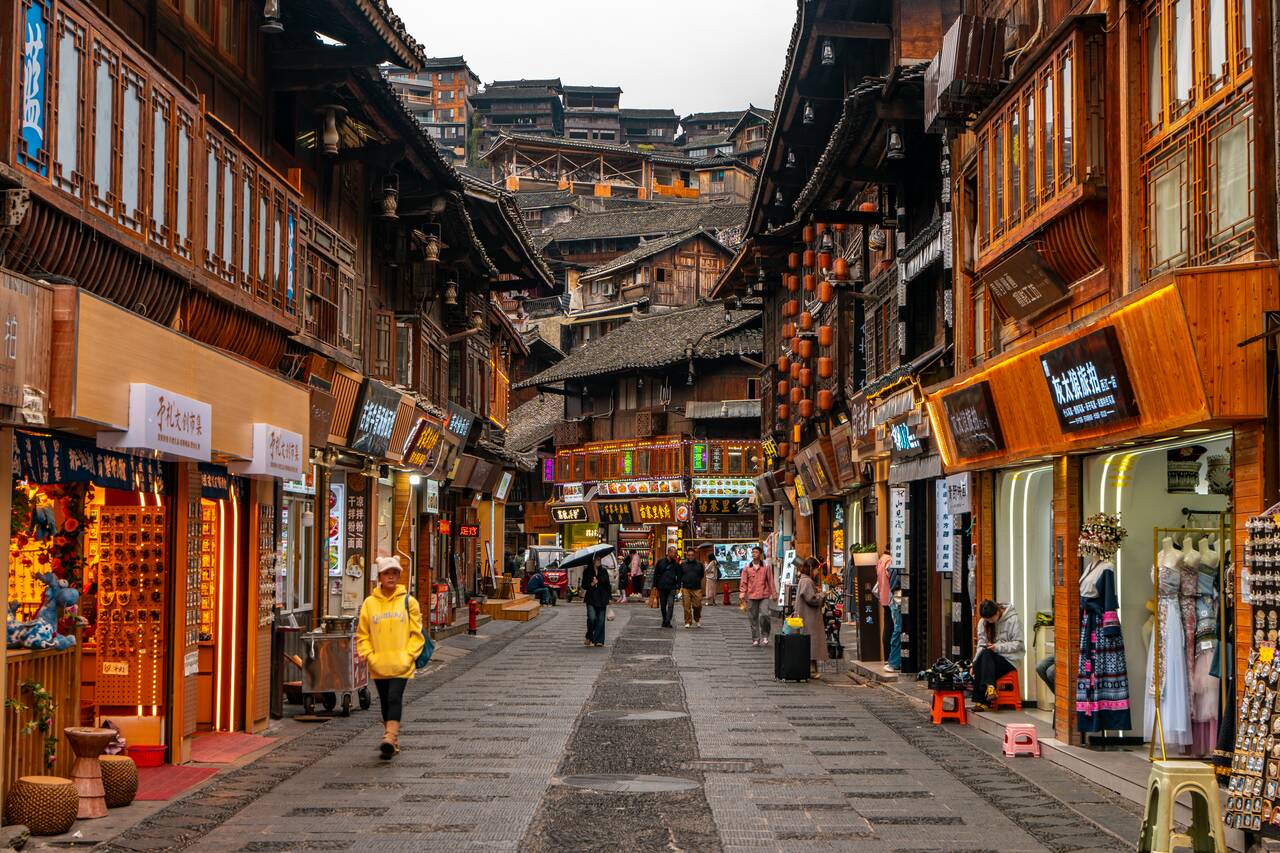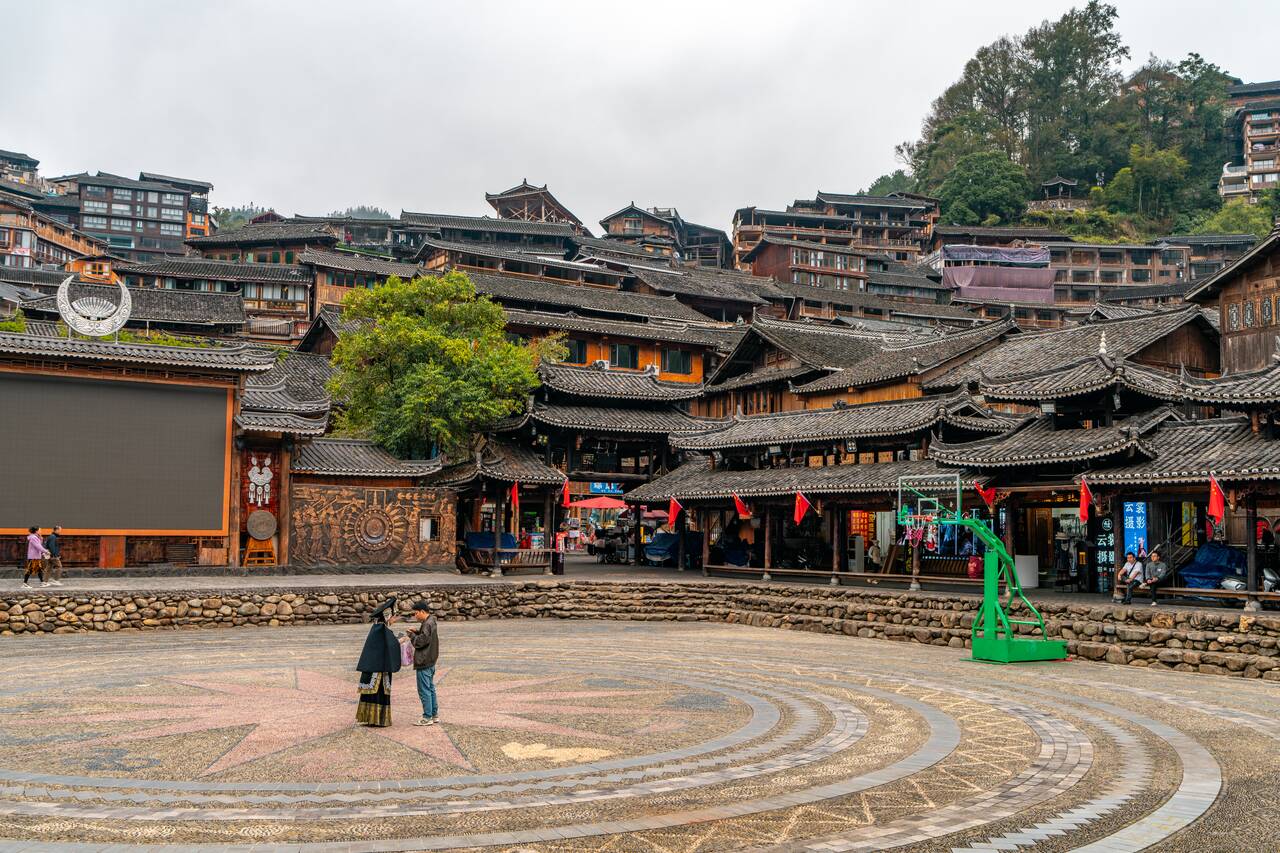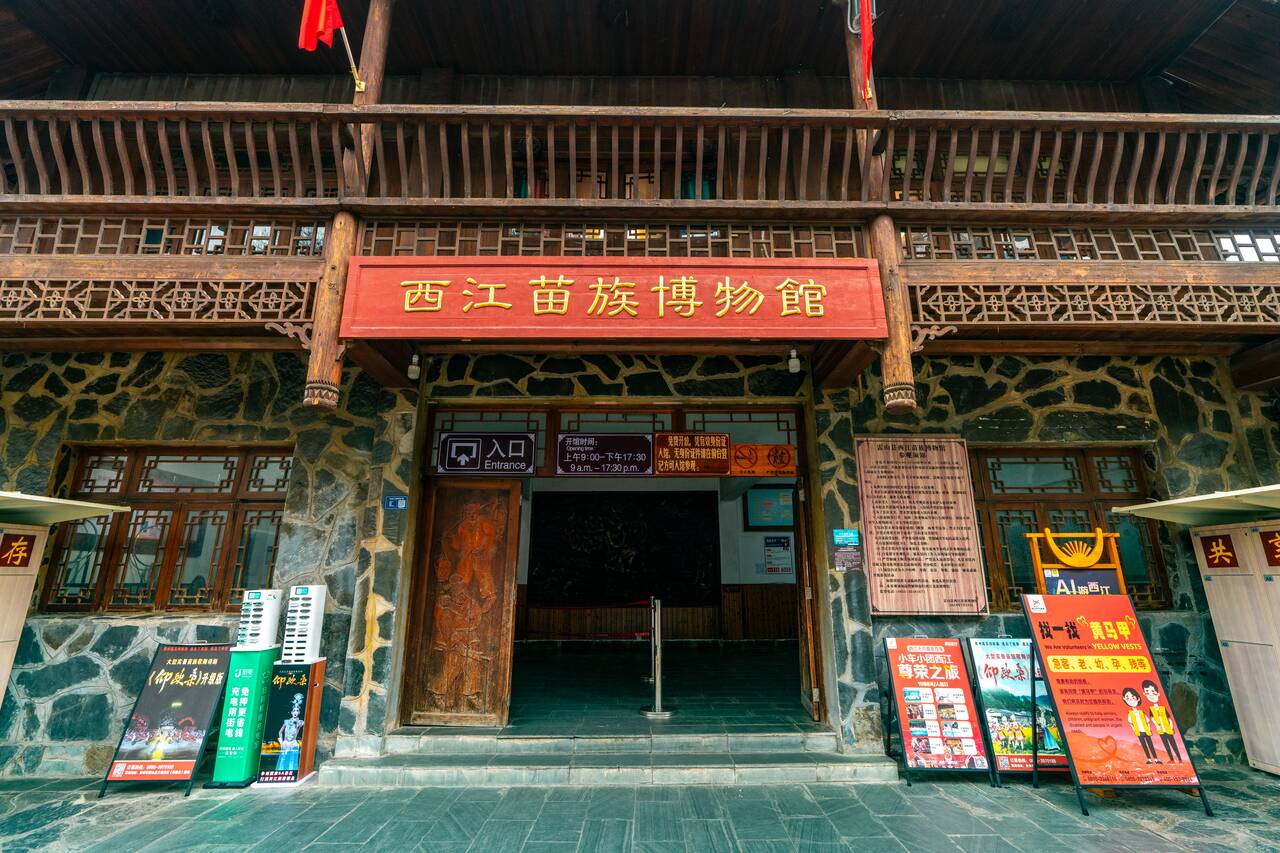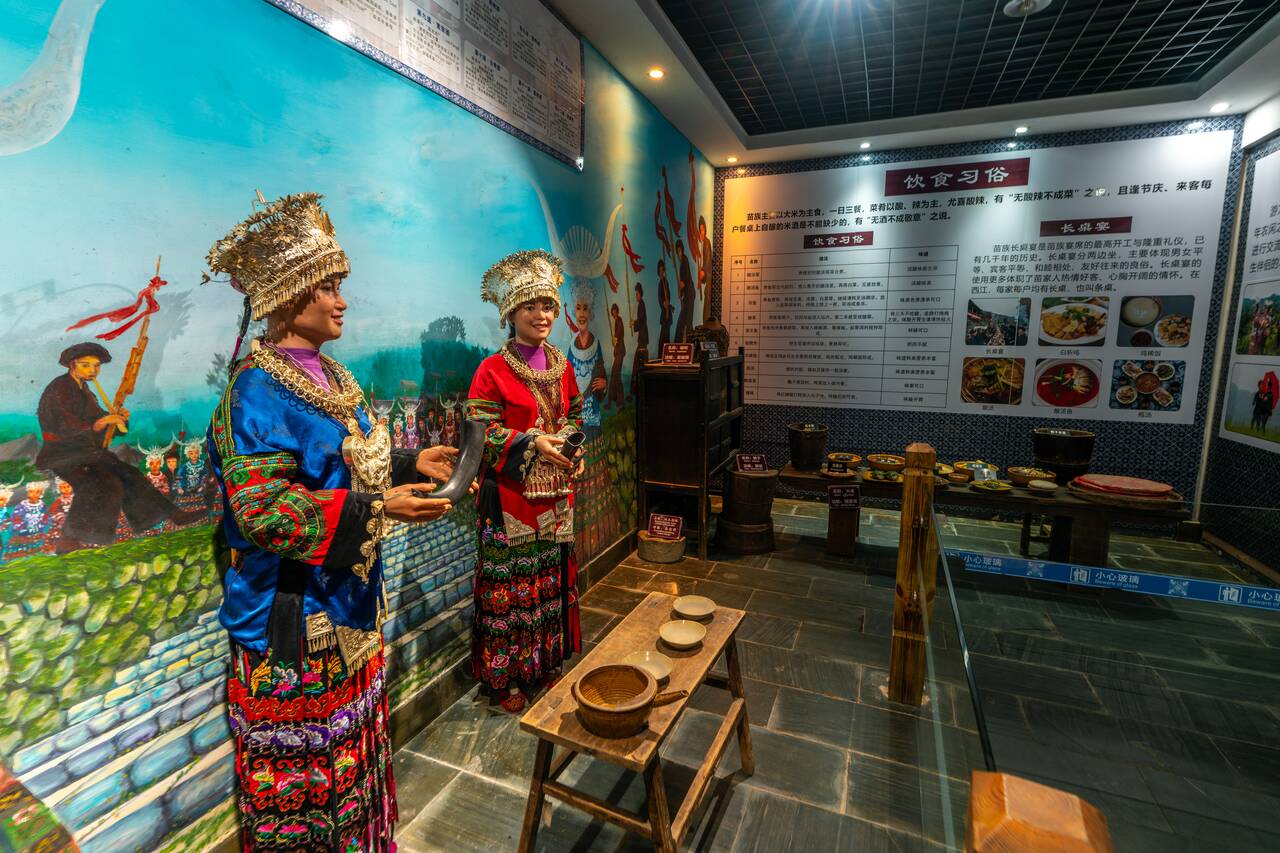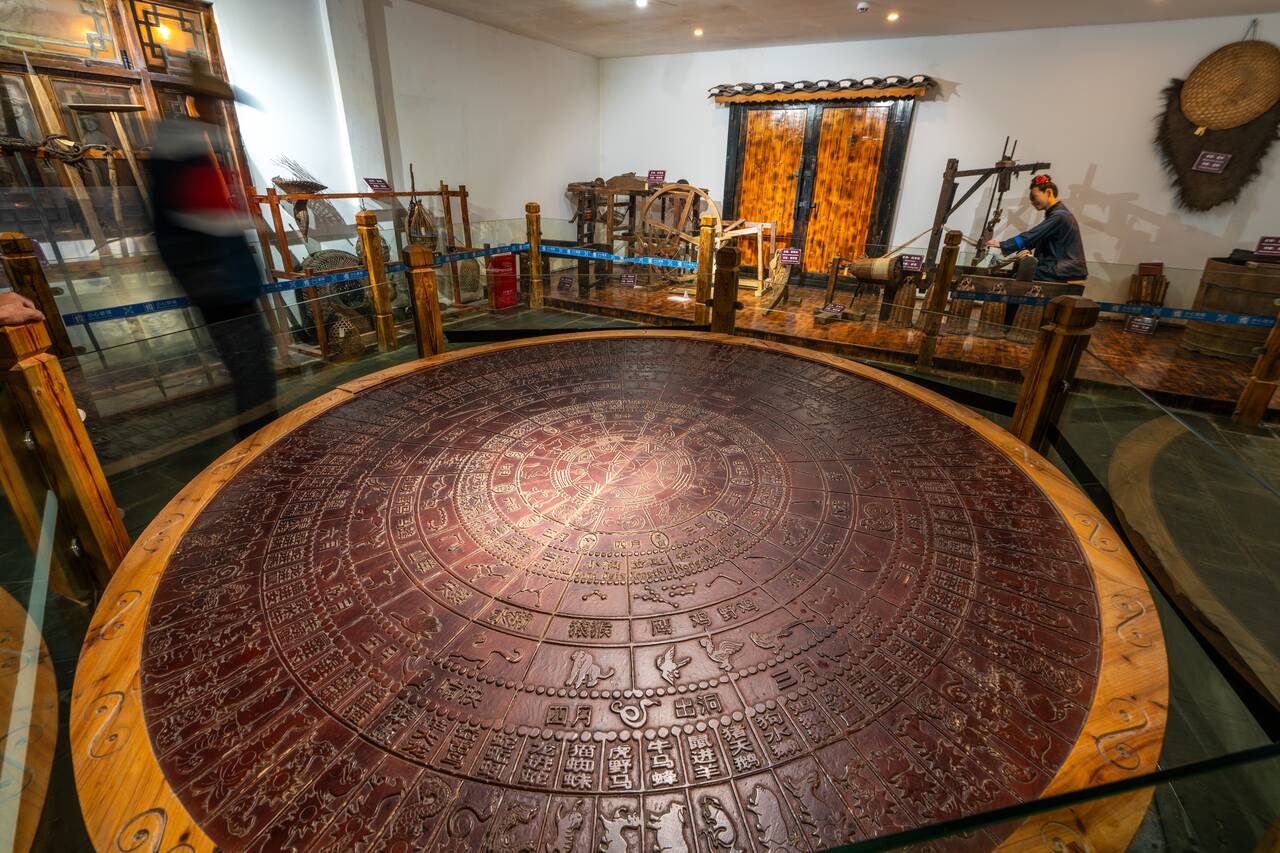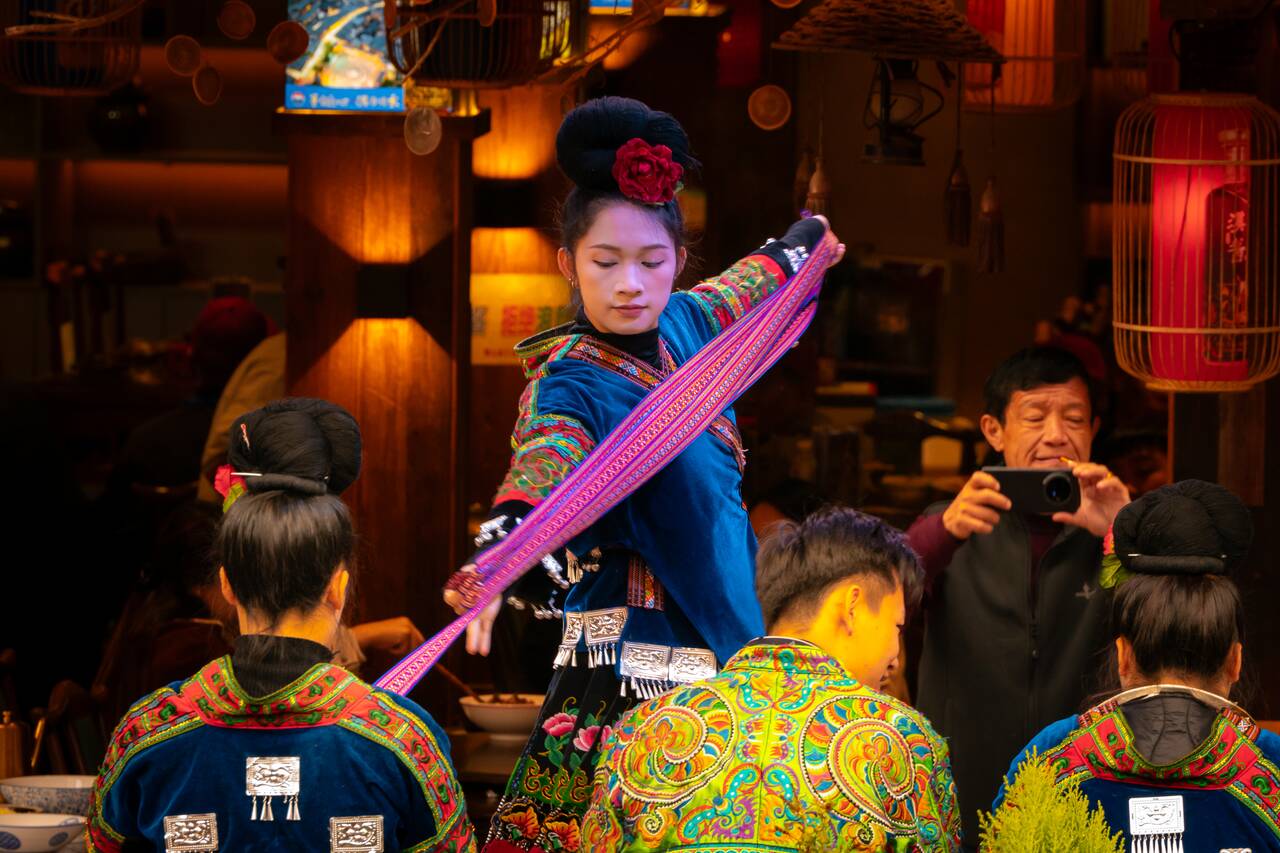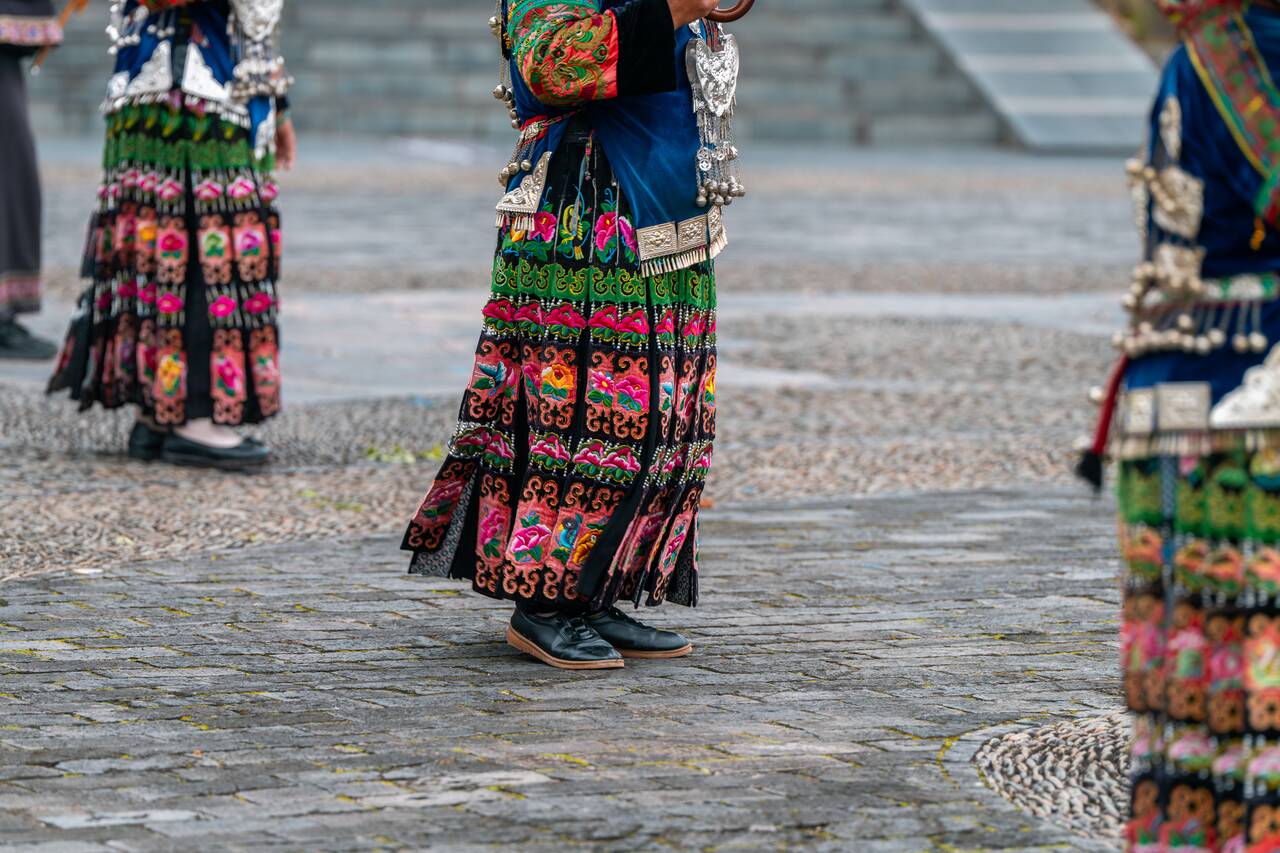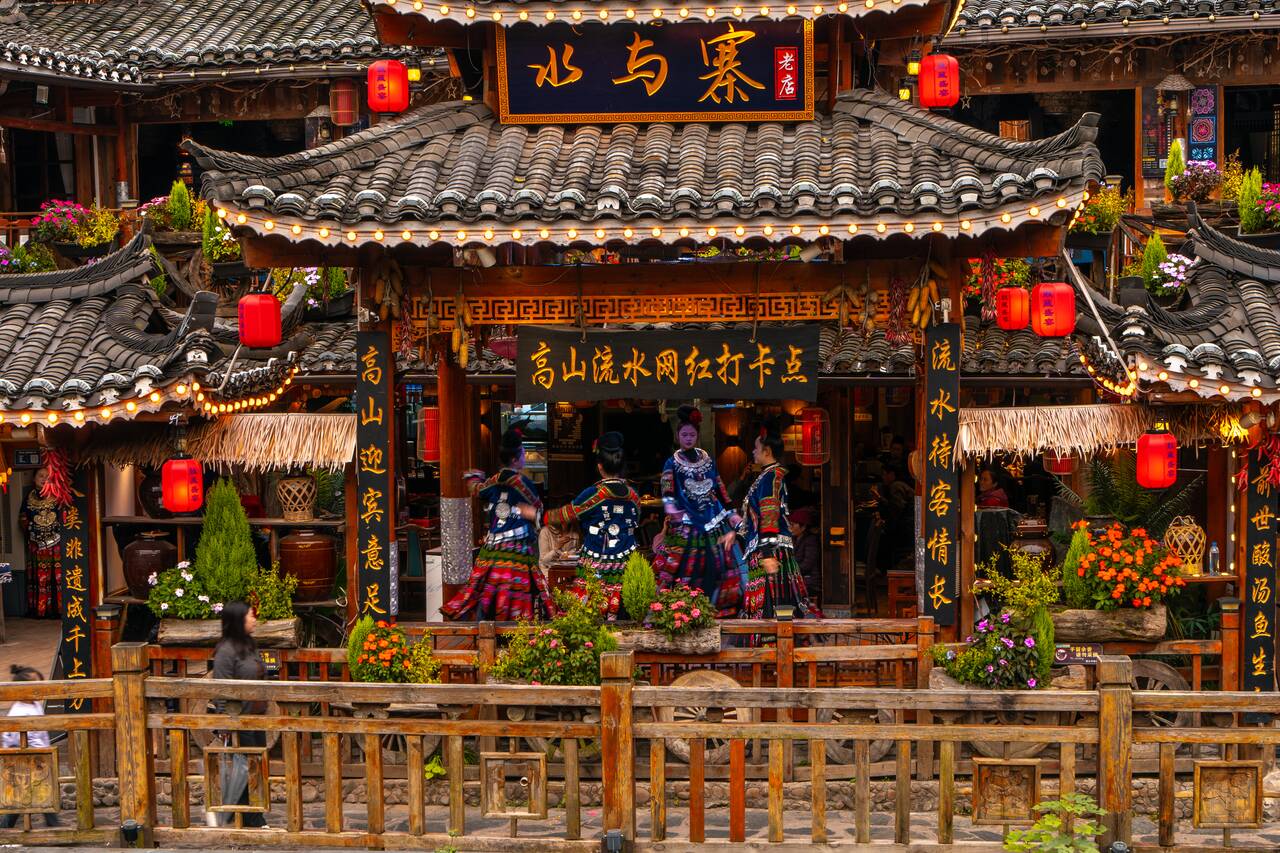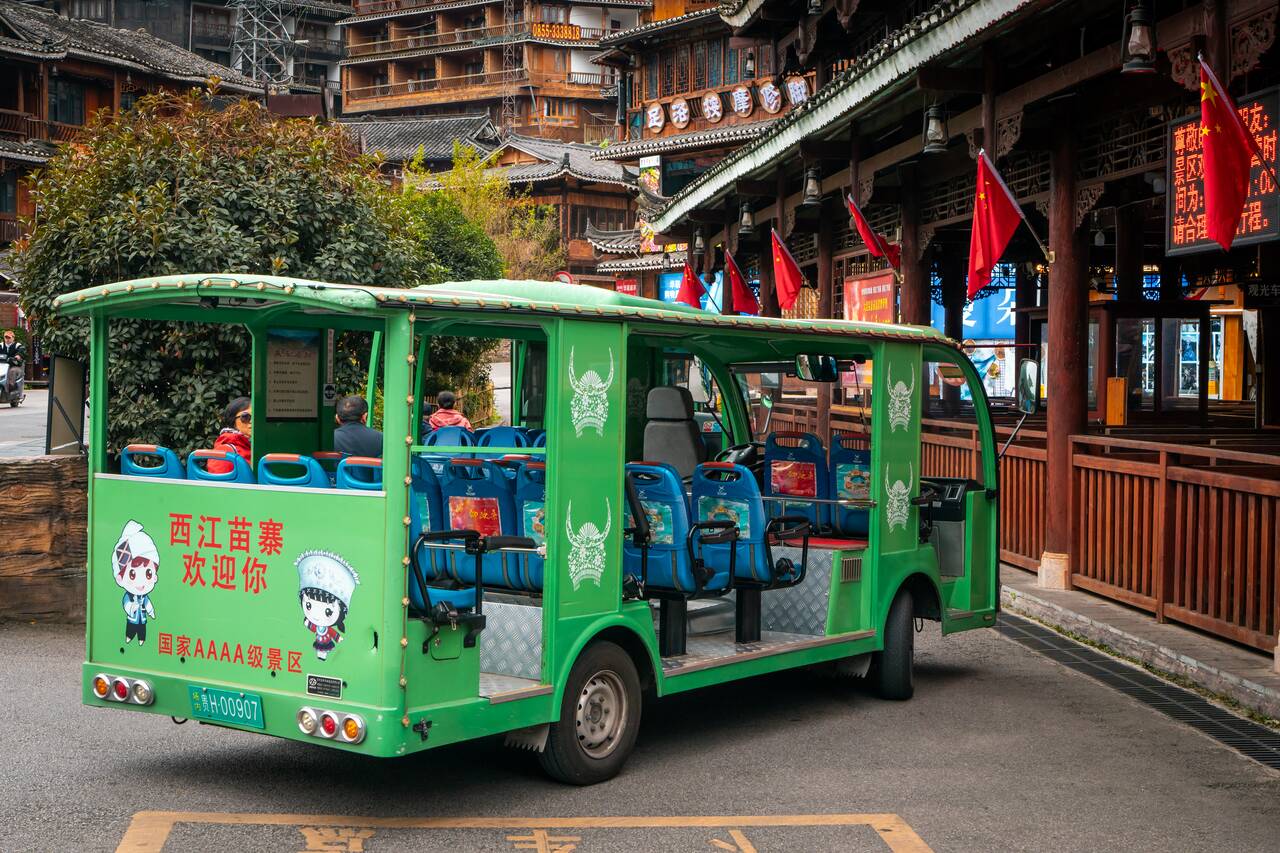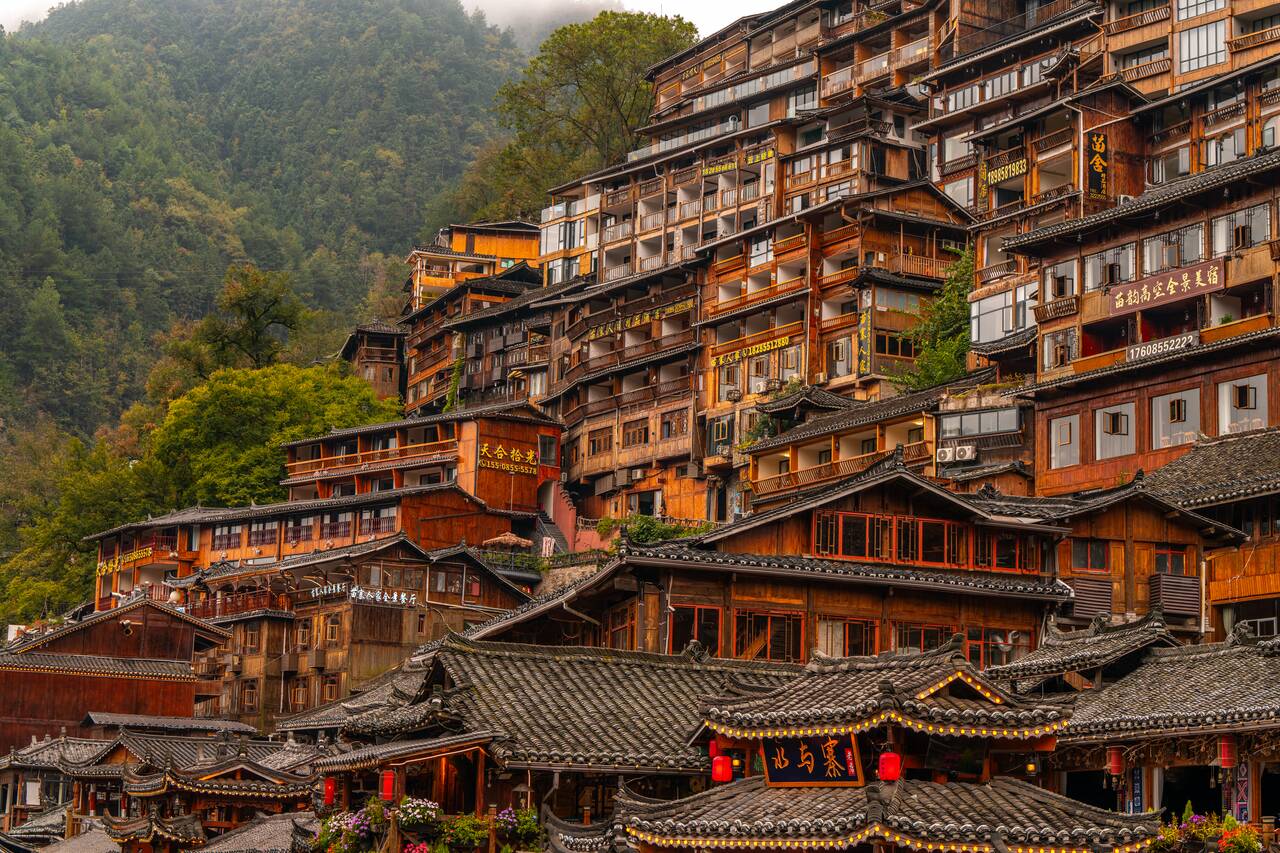If you are visiting Guizhou, one of the most underrated regions in China, you’ll definitely want to visit a traditional Miao village, where the ethnic Miao people live and share their unique culture, traditions, and lifestyle. One of the largest and arguably most beautiful is Xijiang, located on the hillsides of Leishan County, about an hour from Kaili.
That said, like many places in China, Xijiang Village has become somewhat commercialized, and some travelers prefer smaller, more authentic villages such as Langde or Rongjiang. Even so, I still believe Xijiang is one of the most beautiful Miao villages and well worth a visit.
If you’re planning to visit Xijiang Village, you’re in the right place. In this guide, I’ve gathered all the information you need to plan the perfect trip, from how to get there and where to stay, to the best things to do and more. So without further ado, here’s a complete travel guide to Xijiang.
- Xijiang Village Points of Interest Map
- Where to Stay near Xijiang Village?
- 6 Best Things to Do at Xijiang Village
- Things to Know Before Visiting China
- When to Visit Xijiang Village?
- How to Get to Xijiang Village?
- How to Get Around Xijiang Village?
- How Many Days to Stay in Xijiang Village?
- What are Xijiang Village Opening Hours and Entrance Fee?
- What to Pack for Xijiang Village?
- Further Reading for China, Hong Kong, and Macau
Xijiang Village Points of Interest Map
Where to Stay near Xijiang Village?
For places to stay, you have two options. You can either spend the night in Xijiang Village to enjoy the beautiful lights after dark, or stay in Guiyang and make a day trip to the village. If you choose to stay overnight in Xijiang, keep in mind that you will need to use the shuttle bus, which will drop you off at either No. 1 Wind & Rain Bridge or No. 7 Wind & Rain Bridge depending on the gate you entered. From there, you will need to walk to your accommodation, so it’s best to keep your luggage minimal. Here are some recommended hotels in Xijiang Village:
If you prefer to make it a day trip, you can stay in Guiyang instead, which is about a 35-minute high-speed train ride to Kaili, followed by roughly a 1-hour drive to Xijiang. Here are some recommended accommodations:
6 Best Things to Do at Xijiang Village
1. Attend the Welcome Wine-Drinking Ceremony at the Visitor Center
One of the first experiences you will witness is the Welcome Wine-Drinking Ceremony, also called "Twelve Rounds of Welcome Wine", held at the Visitor Center. It begins around 10:30 AM in the front courtyard. I just so happened to arrive around that time and was able to see the Miao people performing music with traditional instruments and dances in their full attire.
During the event, Miao villagers dressed in traditional clothing set up 12 tables, essentially serving as 12 wine stations or "rounds". You can go to each station in order and drink the rice wine offered by the villagers. This is especially enjoyable when it’s freezing cold outside, as it was when I visited in October 🥶.
Here’s a cool fact about the number 12: in Miao culture, it represents a complete cycle or wholeness in their cosmology. Through this ceremony, the locals welcome you with warmth and genuine hospitality. There are many other Miao rituals you can witness as you explore the village so be sure to keep an eye out for them.
With this wine-drinking ceremony, you can choose to either participate or simply watch, as I did, enjoying the traditional music that closely resembles the Hmong instruments found in Northern Thailand. After all, they come from the same people, according to what I’ve read.
2. Admire the view from the Viewing Platform
After you enter the gate, you can catch the sightseeing shuttle bus and get off at the first stop, which is where you will get an incredible vantage point of the Miao Stockaded Village from this viewing platform located on the side of the hill.
From this viewpoint, you’ll get an incredible panoramic view of the entire village from above, with its beautiful old rooftops, wooden houses stacked along the hillside, and the sheer scale of the place, all surrounded by lush green hills. I’ve never seen such a photogenic ancient village before. It’s no wonder it’s considered the largest and most beautiful Miao village out there.
This is also the perfect place to see the village during sunrise, sunset, and at night, as the golden sun rays illuminate the rooftops and the village lights create a magical glow. If you are staying overnight in Xijiang Village, make sure to come up here at sunset and watch the village shine under the moonlight.
From here, you can either walk down to the village and enjoy the view along the way as you descend from the hill or take another shuttle bus all the way down so you can begin exploring the crisscrossing streets of Xijiang.
3. Explore Its Wonderful Cobblestone Streets
Once you reach the bottom, the shuttle bus will drop you off at No. 1 Wind & Rain Bridge, where you can begin exploring the village itself. The view from above is beautiful and all, but if you really want to immerse yourself, you need to be at street level, looking up at the wooden houses stacked along the hillside, towering above you.
There are basically 3 main streets you can take, one running through the village and the other 2 running along the river. On these streets, you will find the usual commercialized shops, cafes, and restaurants where you can enjoy. You will also find museums, town squares, and other points of interest to keep you busy for several hours.
If you prefer to avoid the crowds, simply start climbing one of the hillside trails and you will quickly find yourself away from the main tourist routes. While visiting, be sure to spend time exploring not just the main streets but also the quieter, smaller lanes. In a village like this, you never know what hidden corners or charming places you might discover around the next turn.
4. Check Out Xijiang Miao Ethnic Museum
While you are exploring the lower part of the village, you might also want to go and check out Xijiang Miao Ethnic Museum, a small local museum located not too far from the Lusheng Field, one of the main squares in the village. The museum consists of several rooms spread out across 2 floors.
Each room focuses on a unique aspect of the Miao people, such as their traditional attire with intricate silver ornaments, local cuisine, daily lifestyle displays, and a collection of fascinating artifacts.
Unfortunately, there is very little English description here, but even without it, you can learn a lot and get a good sense of Miao culture. Entrance is free, making it a great spot to take a break from exploring and enjoy a small history lesson while visiting Xijiang Village.
5. Check Out all the Beautiful Bridges of Xijiang
Some of the best views in the village are not found on the main street but along the river. If you want to explore this area, I highly recommend starting and ending at either No. 1 Wind & Rain Bridge or No. 7 Wind & Rain Bridge. These are stunning old bridges with unique architectural designs, located at both ends of the village.
These bridges were originally built to improve Feng Shui and provide convenience for the villagers to commute between the 2 sides. In the past, the Wind and Rain Bridges were entirely wooden and constructed without any nails. Today, they have been rebuilt using a combination of concrete and wood while preserving their traditional design and they are still awesome.
Everyone visiting Xijiang will pass through one of these bridges, but you can take it further by crossing all of them as you explore along the river. The bridges are also a great spot for photos, with their stunning architecture set against the river and the stacked wooden houses. If you have time, be sure to walk the entire length of the riverside routes to fully enjoy the scenery.
6. Enjoy Traditional Performances at the Village
The Miao people are famous for their vibrant performances, with numerous festivals and events held throughout the year. If you happen to visit during one of these times, you will be treated to traditional dances and music. I once read that the Miao have more events than there are days in a year, which is probably an exaggeration, but it does highlight just how rich and lively their culture is.
For example, you might stumble upon a traditional singing being performed at No. 2 Wind and Rain Bridge in the morning around 11:30 AM. You might also catch the Lusheng performance at Old Lusheng Square, Miao batik demonstrations, traditional singing by the elders at Tonggu Lusheng Square, as well as cockfighting and bird-flying events on market days, while you are here.
You can also attend the "Beautiful Xijiang" show to see many of these performances in one place at the Performance Stage. The show takes place every day at 11 AM, and ticket prices range from 80 to 150 CNY per person, depending on your seating choice in the theatre.
You don’t even have to pay to see these performances, as many restaurants along the river often hold smaller versions for their guests, which can be watched from outside. I saw a beautiful dance performance at one of the riverside restaurants, followed by a symbolic ritual called the “High Mountains and Flowing Water” toast, which was fascinating to watch.
The ritual involves pouring wine from the top through a layered bowl system, finally reaching the guest’s bowl. This pouring style symbolizes that Miao hospitality is as high as mountains and their friendship flows as long as water. If you are dining at one of these restaurants, you might even be invited on stage to participate, which is a really fun experience. While visiting Xijiang, be sure to take part in one of these amazing performances or rituals if you get the chance.
Things to Know Before Visiting China
- Always Carry Your Passport: Everything revolves around your passport/ID in China, and it’s often used interchangeably as your main form of identification. Many major tourist attractions require you to show your passport when buying a ticket, and the ticket will then be linked to it. You’ll scan your passport again to enter. The same applies to high-speed trains. It’s best to carry your passport with you at all times while traveling in China.
- Get an eSIM: China’s cashless economy relies on constant internet access, so having a data connection is essential. I highly recommend getting an eSIM or a local SIM card for your trip. An eSIM is often better because the service is usually based in Hong Kong, which bypasses China’s Great Firewall, meaning you can access apps like Instagram and YouTube without a VPN. I suggest checking eSIM options on Klook or Trip.com, as they tend to be the most affordable.
- Use AMap to Navigate: Google Maps doesn’t work well in China, so local apps like AMap are much more informative and accurate for getting around. It even provides metro information, making it easy to navigate city subway systems. I used AMap throughout my entire trip, and it worked perfectly! In this guide, I’ll be linking locations with AMap links instead of Google Maps, so be sure to download it before your trip.
- Use LetsVPN to Bypass the Great Firewall: As you may know, many major websites such as Google, Facebook, Instagram, TikTok, and more are blocked in China. To access them, you’ll need a VPN like LetsVPN installed on both your phone and laptop before you arrive in China. This is crucial as once you're in the country, you won’t be able to search for or download VPN apps. I used LetsVPN during my trip, and it worked very well throughout. The service is affordable too, with a free tier offering limited data or a basic unlimited plan for just 5.99 USD per month.
- Connect Alipay with Your Credit Card: First, download Alipay from the app store, set up your account, and link it to your credit card. This will be one of the two main ways you’ll pay for services in China. Alipay also has mini-apps built in, such as Didi (China’s version of Uber), so you don’t need to download separate apps, and you can use them directly through Alipay. Very convenient!
- Get a Transport Card Working in Alipay: Once you have Alipay set up, you’ll need to verify your account before you can activate a transport card for metro and bus rides. First, if you’re not currently in the city you want to use, tap the city name in the top-left corner and select the correct city. After that, tap the “Transport” button and request a transport card. You’ll be asked to upload a photo of your passport for verification. Once approved, your transport card will be issued, and you can use the QR code to scan and pay for buses and metro rides.
- Get WeChat Set Up: WeChat is another essential app for communicating with locals, thanks to its built-in translation feature. It’s also widely used for payments as Alipay only works about 70% of the time, while WeChat is commonly needed for paying individuals, buying entry tickets at certain attractions, and more. Setting up WeChat can be a bit tricky though because you need verification from an existing user. The easiest way is to ask your hotel’s reception to help verify your account when you arrive in China, which is how I got mine activated.
- Use Trip.com / Trip App: For hotels, day trips, attraction tickets, train tickets, flights, and everything in between, you can use Trip.com or the Trip app to book all your travel needs. It’s very convenient, offers a great user experience, and has a generous cancellation policy that gives you more flexibility when traveling in China.
When to Visit Xijiang Village?
Xijiang can be visited all year round, but spring, from March to May, is one of the most pleasant times to go. The temperatures are mild, ranging from around 15 to 25°C, and rainfall is relatively low, making it comfortable for walking around the village. In spring, you will also have a chance to experience the Sisters’ Meal Festival, usually held in mid-April, one of the many fun annual events the Miao people are famous for.
Summer, from June to August, brings lush green scenery as the surrounding mountains become fully vibrant. Temperatures average around 20°C, making it a comfortable escape from hotter lowland regions like Guilin or Guangzhou. However, summer is also the peak tourist season and the place can be extremely packed during this time.
Autumn, from September to November, is another ideal time to visit. The weather is crisp and cool, and there is less rain compared to summer. Autumn is also when the Miao New Year often occurs (based on the lunar calendar), which can offer a memorable cultural experience with festivals and local celebrations. This season is excellent for photography, as the lighting and natural scenery are particularly beautiful with the autumn colors popping left and right.
I would personally avoid winter, as it can be extremely cold here, with strong winds that seem to cut straight to your bones. I visited in autumn, and even then, it was very cold, a bit damp, and foggy. I can’t imagine how much colder it must get in winter!
It is best to avoid visiting on weekends, as the local tourist crowds can make the experience less enjoyable. This applies to most popular attractions and scenic areas in China. What might be a beautiful and peaceful place can quickly feel crowded and chaotic, so try to plan your visit on a weekday if possible.
How to Get to Xijiang Village?
The best way to get to Xijiang Village from anywhere in China is to first reach a major hub like Guiyang by train or flight. China's high-speed rail network connects most major cities, and Guiyang has an airport with flights from Beijing, Shanghai, Chengdu, and other major cities.
From Guiyang, you can take a high-speed train from Guiyang North Railway Station to Kaili South Railway Station, which should take about 30 minutes and cost 58 CNY. You can book the train here.
Once you arrive at Kaili South Railway Station (Kailionan), turn right the moment you exit the terminal and you will find a travel agency that provides frequent tourist carpool between the railway station and Xijiang Village. Simply find the place in the photo above, and they will take you to the car, and you will be on your way in no time. That's how I did it without speaking a word of Chinese 😅.
The carpool taxi takes about 1 hour and costs around 30–35 CNY one way. You can pay the driver with WeChat. Once you arrive, the taxi will drop you off at the village entrance. For your return trip, simply head back to the entrance and you’ll usually find drivers looking to fill their carpool to the train station.
Make sure they are going to Kailinan before getting in and stand firm on the price of around 30–35 CNY. You should be able to get back in no time.
How to Get Around Xijiang Village?
By Shuttle Bus: Inside the village, you can get around using the shuttle buses that run between the entrance and the village. The service is included in the entrance ticket, so you can hop on and off as often as you like. Buses operate from 7 AM to 12 AM on weekdays, and from 7 AM to 1 AM on weekends.
By Walking: Once you’re in the lower part of the village, you can easily explore its cobblestone streets on foot. There are a few slopes, but most attractions are within a short walking distance.
How Many Days to Stay in Xijiang Village?
Xijiang Village can easily be done as a day trip from Guiyang, which is perfect for those who are short on time or planning to visit other attractions in Guizhou, such as Huangguoshu Waterfall. However, if you have time to spare, I highly recommend spending at least one night in Xijiang.
You see, the village is at its most magical at night when the lights illuminate the cobblestone streets and traditional wooden houses. If you want incredible blue-hour photos of the village, staying at least one night gives you the best chance to capture it at its very best.
What are Xijiang Village Opening Hours and Entrance Fee?
Xijiang Village is open from 7:30 AM to 11:59 PM daily, but you can still stay overnight in the village. The shuttle bus runs from 7 AM to 12 AM on weekdays and 7 AM to 1 AM on weekends.
The entry ticket is 90 CNY per person, including the sightseeing shuttle bus, and you can either get the ticket at the entrance or book one online here.
What to Pack for Xijiang Village?
As you may already know, I am an advocate of light traveling, and indeed, packing light for a journey like this is a unique art form. Here are some packing tips for your upcoming trip to Xijiang Miao Village, China:
- Walking/Hiking Shoes: With all the walking and possible hiking during your travel, a comfortable pair of shoes is a must. I recommend the Timberland 3-Eye Classic Boat Shoes that are my go-to pair for long strolls and hikes.
- Breathable Shirts: Given the potential for hot weather, pack a few breathable shirts for your outdoor adventures.
- Shorts/Jeans: Anticipate lots of walking during your travels? Be sure to pack some breathable shorts and a pair of Levi's jeans for when the weather cools. For women, leggings are excellent for both hot and cold climates, so consider packing some as well.
- Fleece Jacket: For colder weather, layering is the key, and a fleece jacket makes an excellent insulating layer. I recommend the Columbia Steens Mountain Fleece (for women).
- Outer Shell Jacket: An outer shell jacket is great for windy or rainy conditions. I highly recommend the Columbia Watertight Jacket (for women). It's lightweight, breathable, and even comes in a cool orange color.
- Microfiber Towel: A Microfiber towel is the ideal backpacker's towel due to its lightness, quick drying, and compressibility.
- Camera: You should also pack a good camera for your trip so that you can capture all the beautiful experiences you might have. I recommend the Sony a7R V camera together with the Sony 24-70mm f2.8 GM II lens, which is probably the highest-performance camera and lens combination you can get right now.
- Power Bank: Keep your electronics charged on the go with a 20,000+ mAh Power Bank.
- Water Bottle: The Hydro Flask Trail Water Bottle is a great insulated water bottle to have with you in cities or on hiking trails. It is lightweight and can keep your water cold or warm for more than 12 hours. It's a total game-changer.
- Universal Adapter: You'll need just one universal adapter to plug in your electronics in any country you visit.
- Packing Cubes: Packing Cubes will help you save space in your backpack and keep all your belongings organized.
- Daypack: The Langly Alpha Globetrotter is my go-to everyday camera backpack. It's large enough to carry all my travel gear, and it comes with plenty of slots and pouches. Plus, it's stylish as hell!
- Large Backpack: You will need a large backpack to carry all of your stuff. I recommend the Osprey Atmos AG 65L backpack. With excellent weight distribution and a lifetime guarantee, you can't go wrong with Osprey.
For more information on what I pack in my backpack for this trip, check out: My Packing List: 60 Travel Essentials.
Now that we have all the information we need, it's time to start planning your trip! Here are some resources to help you get going:
Are you planning to travel independently? Be sure to check out my guide on How To Plan A Backpacking Trip here.
Further Reading for China, Hong Kong, and Macau
Looking for more information about your trip to China, Hong Kong, and Macau? Here are a collection of articles that you might find useful:
- Want to spend 5 days in Hong Kong? Here's a complete itinerary for you: Hong Kong in 5 Days: A Backpacker's Itinerary.
- First time in Hong Kong, but you are not sure where to begin? This is the guide for you: Visiting Hong Kong: 12 Awesome Things to Do & More.
- Macau is often called the Las Vegas of Asia, offering larger-than-life entertainment, a unique blend of Portuguese heritage, and so much more. If you’re planning a visit, be sure to check this out: Discover Macau: 10 Cool Things to Do & More.
- Guangzhou is the fourth-largest city in China and one of the wealthiest, with major trade activities taking place in and around the city for over 2,000 years. With so much history and so many places to explore, you’ll definitely want this comprehensive travel guide: Explore Guangzhou: 12 Incredible Things to Do & More.
- Guilin is, hands down, one of the most beautiful places I’ve seen in China. If you’re planning to visit, here is the comprehensive travel guide I wish I had! Check it out: Visiting Guilin: A Complete Travel Guide
- Looking for a complete itinerary to Guilin? Check out: 5-Day Itinerary in Guilin
- Want to visit Huangguoshu Waterfall, the largest waterfall in Asia? Check out this travel guide: Huangguoshu Waterfall: A Complete Travel Guide
- Dali is one of Yunnan’s most charming and culturally rich destinations and a great place to start acclimatizing before visiting other high-altitude areas in the province. If you are planning a trip, be sure to check out this travel guide: Exploring Dali: A Complete Travel Guide
- Yulong Snow Mountain, one of the most beautiful mountains in Yunnan, is located in Lijiang, a destination you shouldn’t miss when visiting China. If you plan to visit Lijiang, check out our travel guide: Exploring Lijiang: 10 Best Things to Do & More
- The mythical town of Shangri-La, made famous by the novel "Lost Horizon", is real and located in China. If you want to visit Shangri-La, this travel guide provides all the information you need to plan the perfect trip: Discover Shangri-La: A Complete Travel Guide
- For more articles about China, visit the China travel guide, or explore my guides to Hong Kong and Macau.
- Planning a trip to East Asia? Explore all my articles on the East Asia Travel Guide page.
- You can find all my Asia-related articles here: Asia Travel Guide.
- For more of my travel guides like this, visit my Destinations page.
Disclosure: This post may contain affiliate links.
